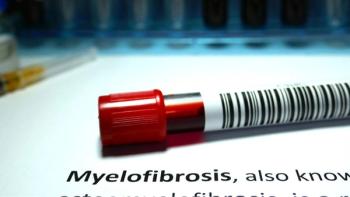
Tecentriq Plus Chemoradiation May Be Safe, Effective in Unresectable Stage 3 NSCLC
Patients with unresectable stage 3 non-small cell lung cancer treated with Tecentriq before and following chemoradiation may derive a survival benefit.
Tecentriq (atezolizumab) administered before and after chemoradiation was observed to be safe and efficacious, providing potential survival benefits and disease control unresectable stage 3 non-small cell lung cancer (NSCLC), according to data from the phase 2 nonrandomized AFT-16 trial published in JAMA Oncology.
After 12 weeks of neoadjuvant Tecentriq (62 patients), the disease control rate (the percentage of patients whose disease either remained stable or shrank over time from treatment; DCR) was 74.2%, with 27.4% of patients experiencing a partial response (decrease in tumor size or extent of cancer in the body; PR) and 46.8% achieving stable disease (cancer that does not increase or decrease in severity or extent; SD). After six weeks of treatment, the DCR was 77.4%. Moreover, the objective response rate (the percentage of patients with a partial or complete response to treatment; ORR) achieved with the approach was 66.2%, and this was comprised of a complete response rate (disappearance of all signs of cancer from treatment) of 8.1% and a PR rate of 58.1%; 11.3% of patients had SD.
A total of 18 patients died, and the median follow-up for the remaining 44 patients was 31.2 months. The median progression-free survival (the time during and after treatment when a patient with cancer is alive without disease worsening; PFS) was 30 months with 12- and 24-month PFS rates of 68.9% and 54.2%, respectively. The median overall survival (the time when a patient with cancer is still alive; OS) was not reached; the respective OS rates at 12 and 24 months were 87.0% and 73.7%. Of note, when an outcome is not reached in a clinical trial, it means that half of the patients in the trial are alive when this was assessed by researchers.
“The AFT-16 trial is the first to our knowledge to report outcomes from neoadjuvant [Tecentriq] preceding definitive [chemoradiation] for patients with unresectable stage 3 NSCLC. Neoadjuvant [Tecentriq] appeared to be safe with encouraging PFS and OS rates,” Dr. Helen J. Ross, lead study author, director of research and clinical trials, professor in the Department of Internal Medicine, and interim chief of the Division of Hematology, Oncology, and Cellular Therapy at RUSH Cancer Center, in Chicago, and coauthors, wrote in the paper. “…Based on the favorable outcomes, neoadjuvant [Tecentriq] therapy merits further study in this patient population.”
Patients with unresectable, histologically confirmed, stage 3A/B NSCLC who were at least 18 years of age, treatment-naive, have an ECOG performance status of 0 or 1 (either fully active with no restrictions or with limitations on strenuous physical activity), and acceptable laboratory and pulmonary function were enrolled to the phase 2 trial.
Treatment consisted of intravenous (IV) Tecentriq followed by chemoradiation with carboplatin and paclitaxel.
Moreover, two cycles of consolidation treatment comprised of carboplatin and paclitaxel every 21 days were given before adjuvant Tecentriq every 21 days to complete 1 year of treatment.
The primary focus of this study was to assess 12-week DCR. In addition, other areas of interest included PFS, OS, ORR and safety.
The median patient age was 63.9 years. Most patients were women (51.6%), former smokers (61.3%), had stage 3A disease (53.2%), and an ECOG performance status of 0 (56.5%). Only 3.2% of patients had recurrent disease following resection.
Findings from an analysis of the patients who completed chemoradiation (44 patients) indicated that the median PFS with the approach was not reached, and the 12- and 24-month PFS rates from the end of chemoradiation were 76.2% and 66.3%, respectively. The 12- and 24-month OS rates from the end of chemoradiation were 95.5% and 83.8%, respectively.
Regarding safety, 48.4% of patients experienced severe or worse treatment-related side effects. The most common treatment-related and immune-related grade 3 or 4 (severe or life-threatening) side effects reported in at least 5% of patients included decreased lymphocyte count (a type of white blood cell), lung infection, decreased white blood cell count, decreased neutrophil count (a type of white blood cell that helps the body fight infection), dyspnea (shortness of breath), hypertension (high blood pressure), fever (6.5%; 0%), hyponatremia (lower than normal sodium levels in the blood), thromboembolic event (blood clots), esophagitis (inflammation of the esophagus), colitis (inflammation of the colon), hyperglycemia (high levels of glucose in the blood), hypoxia (decreased oxygen to tissue), infusion-related reaction, pneumonitis (inflammation of the lungs, vomiting, decreased platelet count, upper respiratory tract infection, sepsis, increased aspartate aminotransferase (which may indicate liver damage), Guillain-Barré syndrome (a rare neurological disorder), hypotension (low blood pressure), pericardial effusion (excess fluid around the heart), respiratory failure, treatment-associated secondary malignant neoplasm, and ventricular tachycardia (fast heartbeat). Two grade 5 effects (death related to the side effect) occurred in the form of pneumonitis and sepsis.
Side effects led to study therapy discontinuation for 19.4% of patients. In these 12 patients, the respective 12- and 24-month OS rates with the regimen were 90.9% and 70.1%.
For more news on cancer updates, research and education, don’t forget to




